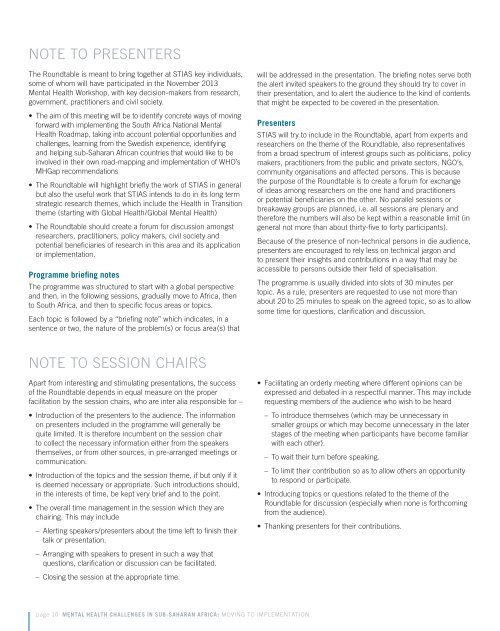Conference-booklet-final
Conference-booklet-final
Conference-booklet-final
You also want an ePaper? Increase the reach of your titles
YUMPU automatically turns print PDFs into web optimized ePapers that Google loves.
NOTE TO PRESENTERS<br />
The Roundtable is meant to bring together at STIAS key individuals,<br />
some of whom will have participated in the November 2013<br />
Mental Health Workshop, with key decision-makers from research,<br />
government, practitioners and civil society.<br />
• The aim of this meeting will be to identify concrete ways of moving<br />
forward with implementing the South Africa National Mental<br />
Health Roadmap, taking into account potential opportunities and<br />
challenges, learning from the Swedish experience, identifying<br />
and helping sub-Saharan African countries that would like to be<br />
involved in their own road-mapping and implementation of WHO’s<br />
MHGap recommendations<br />
• The Roundtable will highlight briefly the work of STIAS in general<br />
but also the useful work that STIAS intends to do in its long term<br />
strategic research themes, which include the Health in Transition<br />
theme (starting with Global Health/Global Mental Health)<br />
• The Roundtable should create a forum for discussion amongst<br />
researchers, practitioners, policy makers, civil society and<br />
potential beneficiaries of research in this area and its application<br />
or implementation.<br />
Programme briefing notes<br />
The programme was structured to start with a global perspective<br />
and then, in the following sessions, gradually move to Africa, then<br />
to South Africa, and then to specific focus areas or topics.<br />
Each topic is followed by a “briefing note” which indicates, in a<br />
sentence or two, the nature of the problem(s) or focus area(s) that<br />
will be addressed in the presentation. The briefing notes serve both<br />
the alert invited speakers to the ground they should try to cover in<br />
their presentation, and to alert the audience to the kind of contents<br />
that might be expected to be covered in the presentation.<br />
Presenters<br />
STIAS will try to include in the Roundtable, apart from experts and<br />
researchers on the theme of the Roundtable, also representatives<br />
from a broad spectrum of interest groups such as politicians, policy<br />
makers, practitioners from the public and private sectors, NGO’s,<br />
community organisations and affected persons. This is because<br />
the purpose of the Roundtable is to create a forum for exchange<br />
of ideas among researchers on the one hand and practitioners<br />
or potential beneficiaries on the other. No parallel sessions or<br />
breakaway groups are planned, i.e. all sessions are plenary and<br />
therefore the numbers will also be kept within a reasonable limit (in<br />
general not more than about thirty-five to forty participants).<br />
Because of the presence of non-technical persons in die audience,<br />
presenters are encouraged to rely less on technical jargon and<br />
to present their insights and contributions in a way that may be<br />
accessible to persons outside their field of specialisation.<br />
The programme is usually divided into slots of 30 minutes per<br />
topic. As a rule, presenters are requested to use not more than<br />
about 20 to 25 minutes to speak on the agreed topic, so as to allow<br />
some time for questions, clarification and discussion.<br />
NOTE TO SESSION CHAIRS<br />
Apart from interesting and stimulating presentations, the success<br />
of the Roundtable depends in equal measure on the proper<br />
facilitation by the session chairs, who are inter alia responsible for –<br />
• Introduction of the presenters to the audience. The information<br />
on presenters included in the programme will generally be<br />
quite limited. It is therefore incumbent on the session chair<br />
to collect the necessary information either from the speakers<br />
themselves, or from other sources, in pre-arranged meetings or<br />
communication.<br />
• Introduction of the topics and the session theme, if but only if it<br />
is deemed necessary or appropriate. Such introductions should,<br />
in the interests of time, be kept very brief and to the point.<br />
• The overall time management in the session which they are<br />
chairing. This may include<br />
– Alerting speakers/presenters about the time left to finish their<br />
talk or presentation.<br />
– Arranging with speakers to present in such a way that<br />
questions, clarification or discussion can be facilitated.<br />
– Closing the session at the appropriate time.<br />
• Facilitating an orderly meeting where different opinions can be<br />
expressed and debated in a respectful manner. This may include<br />
requesting members of the audience who wish to be heard<br />
– To introduce themselves (which may be unnecessary in<br />
smaller groups or which may become unnecessary in the later<br />
stages of the meeting when participants have become familiar<br />
with each other).<br />
– To wait their turn before speaking.<br />
– To limit their contribution so as to allow others an opportunity<br />
to respond or participate.<br />
• Introducing topics or questions related to the theme of the<br />
Roundtable for discussion (especially when none is forthcoming<br />
from the audience).<br />
• Thanking presenters for their contributions.<br />
page 10 MENTAL HEALTH CHALLENGES IN SUB-SAHARAN AFRICA: MOVING TO IMPLEMENTATION


